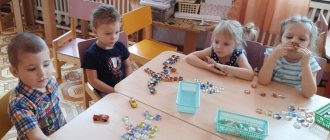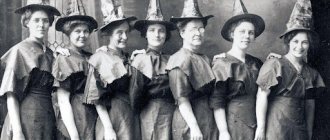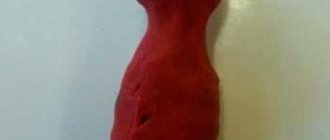Lesson notes on FEMP in the second junior group “Square”
Goals: to develop children’s ability to distinguish and correctly name a square and a circle, to practice tactile-motor examination of figures, to teach children to compare objects by size, shape and color, to name geometric figures.
Develop attention and memory;
Cultivate sense of purpose, the ability to complete a task started, and the ability to act together. Develop self-confidence and love for mathematics.
Material:
Set of geometric shapes: circles and squares. Hoops. Poster depicting a square and objects similar to the square, “Wonderful Bag”.
Progress of the lesson:
Educator: Hello guys, I’m in a good mood today, and I want to share it with you, and for this I will pass my smile to you in a circle (the teacher smiles at the child standing next to him, this child smiles at his neighbor, etc.)
Educator: Well done, you and I shared our good mood with each other.
Educator: Now do you want me to tell you a fairy tale?
Children's answers.
Educator: Once upon a time there was a circle. He went for a walk, rolled and rolled along the path. (Puts the circle on the board.) Suddenly he sees someone strange, unlike him, coming towards him. (Exposes a square.)
"Who are you?" - the circle was surprised.
“I’m a square, and who are you?”
“I am a circle. Let’s take a walk together, let’s ride along the path together.”
I tried to roll the square, but it couldn’t. (Tries to roll the square.) The circle was surprised, began to look at the square and saw that the square has these 4 sides (circles them with his finger) and there are 4 corners - here they are (points).
“Ah, I understand why you can’t roll,” the circle laughed.
Have you guys guessed what prevents the square from rolling?
Children examine the square with their fingers and try to roll it. And they come to the conclusion that a square cannot roll, since it has corners and they interfere with rolling, but a circle does not have them, and therefore it rolls.
Educator: Correct. Now, let's check how you remember the difference between a square and a circle. Let's play with you
Game of "Wonderful Bag".
Didactic game with flat geometric shapes. Children, putting their hand into the bag, recognize the figure by touch and name it. (Circle and square).
Educator: Well done guys.
Educator: Did you like playing?
Children's answers.
Educator: Then I suggest you play one more game.
Game "Find your house".
Educator: Look, each figure lives in its own house, and when evening comes, it returns to that house on the door of which the corresponding figure is depicted. You, too, must find your house, and the figure that I will give you will tell you who lives where.
There are geometric shapes in hoops on the floor. The teacher hands out various cardboard figures to the children. At the teacher’s command “day”, the children walk, jump, and dance. On the command “night”, they take places in the circle, in accordance with the figure in their hand.
Educator: Let's check if you found your houses correctly. What a great fellow you are. Now sit quietly at the tables.
The children sit down.
Educator: Guys, look at your plates there are geometric shapes. Guys, what are these figures called?
Children's answers.
Educator: That's right, these are squares.
Educator: Look carefully, are they all the same?
Children's answers.
Educator: How are they different?
Children's answers.
Educator: Well done. Some are big, others are small. How can you check this?
Children's answers.
Educator: That's right, they can be checked by applying them and tracing them with your finger. You need to put a small square on a large square and circle it with your finger. What is the difference between squares?
Children's answers.
Educator: That's right, they are different colors.
Educator: What color are the big squares?
Children: Large red squares.
Educator:
What color are the little squares?
Children: Small blue squares.
Educator: Tell me, how are these squares similar?
Children: They are the same shape.
Educator: Correct. Guys, let’s look at the poster and name the objects that look like a square.
Children's answers.
Educator: What geometric figure did we get to know better today?
What do you remember most? What is the difference between a circle and a square?
Children's answers.
This concludes our lesson for today. Well done boys!
Summary of GCD for FEMP in the second junior group. Introducing the Voskobovich square
Abstract of GCD for children 3-4 years old “Introduction to V.V. Voskobovich’s square”
Objectives: Introduce V.V. Voskobovich’s two-color square. Develop sensory abilities and basic mathematical concepts. Form ideas about geometric shapes (triangle, square) at the image level. Activate children's speech and creative thinking. Develop fine motor skills of the fingers.
Progress of the lesson:
Children stand in a circle.
Low mobility game “All the children gathered in a circle.” I am your friend and you are my friend! Let's hold hands together and smile at each other. We'll hold hands and smile at each other. We'll go in circles. Let's start a round dance. (Walking in a circle) Guys, do you like fairy tales? (Children's answers.) Why do you love them? MAGIC AND VARIOUS MIRACLES HAPPEN IN FAIRY TALES. And in our kindergarten, miracles also happen. Look (fairytale music sounds) someone left us a chest, and what is there. The teacher takes out two-color squares. (Let the children touch and examine). Introduction to the Voskobovich square V.V. -Once upon a time there was a circle.
He went for a walk, rolled and rolled along the path. Suddenly he sees someone strange, unlike him, coming towards him. -"Who are you? - the circle was surprised. - “I’m a square, and who are you? " -“I am a circle. Let's ride down the path together." -I tried to roll the square, but it couldn’t. The circle was surprised, began to look at the square and saw that the square had corners. “Oh, I understand why you can’t roll,” the circle laughed. -What do you guys think prevents the square from rolling? History: In the most ordinary city, in the most ordinary house, there lived a very ordinary family: mother is a trapezoid, father is a rectangle and their son is Square. The square had no brothers or sisters, but there was a grandfather, a quadrangle, who lived in another city. Grandfather lived far away and therefore often wrote letters. One day dad said that yesterday he again received a letter from grandfather. Grandfather says hello to everyone, wishes them good health and asks who his favorite square dreams of becoming. Transformation of a square. (House). After breakfast, mom and dad left, and the square was left at home alone. I wonder what I can become? — Kvadrat remembered his grandfather’s question and went to the mirror. An ordinary square was looking at him, with all sides equal and all angles equal. (run your finger along the side of the square, find the corners) “The same everywhere and unremarkable,” the square thought to himself. On one side I am green, and on the other (children turn over the square) I am (what?) red. After that, our square decided to go out into the yard. He went out, walked along the path to the park, and suddenly in the depths of the park he saw a beautiful house. “I wish I could become such a house,” thought the square and suddenly felt that its corners began to move, and it somehow formed unusually. And the square turned into a house!!! (put the square in a square, bend the top corners)
He was very surprised and turned into a square again. These are some interesting squares we have. Did you like it? What did you guys like about them?
We recommend watching:
GCD in mathematics in the second junior group. Summary of GCD for FEMP in junior group 2. Summary of GCD for FEMP on the topic: Circle. Second junior group Notes of GCD in mathematics in the junior group of kindergarten. Geometric figures
Similar articles:
Mathematics day in kindergarten in the second junior group




